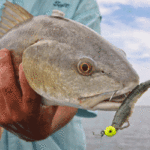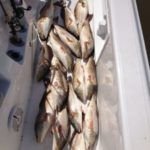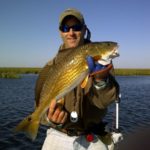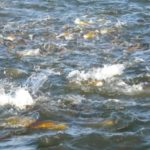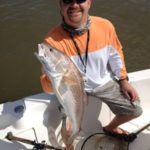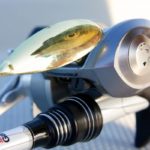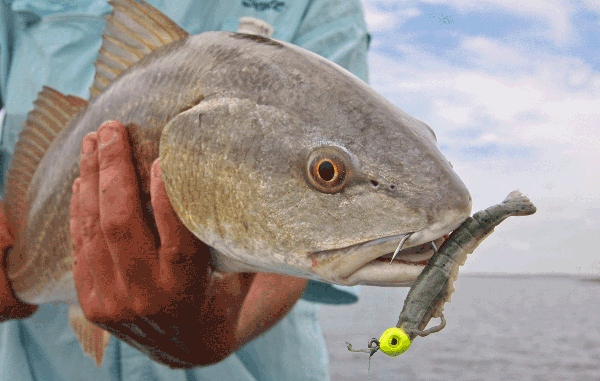
Learn how to change fishing tactics to continue catching Dularge redfish during the transitional month of October.
Three days after Hurricane Isaac raked across coastal Louisiana, Capt. Marty LaCoste launched his 24-foot Blue Wave Pure Bay from Jugs Landing at the end of Highway 315 below Houma in Terrebonne Parish.
He knew what he was looking for, but he wasn’t sure he was going to find it.
Turns out, after making a loop from Lake Mechant into Sister Lake, down to the coast, up Pelican Pass and on into Bay Junop and King Lake, he found no birds and no clear water.
His catch for the day included a couple of redfish, a black drum and a freshwater catfish.
Things were a lot better for him two days later.
“We hooked up with 30 redfish today, and we kept our 15,” he told me at the conclusion of his trip on Sept. 3. “I remembered what we had done on Tuesday before the storm when we had our four-man limit of redfish at 8 in the morning.”
According to LaCoste, what he had done on that Tuesday before the storm to catch redfish was the exact same thing he’s done every September and October for the last few years — fish cracked crab on the bottom.
“The cracked-crab redfish bite actually begins in August,” LaCoste noted. “But it runs all the way through September and on into the first two weeks of October.
“The redfish bite doesn’t disappear at the end of those two weeks, but you will have to change the way you fish for them.”
In other words, October redfishing in Bayou DuLarge, where there doesn’t seem to be any bad months for catching redfish, is a tale of two weeks — the first two weeks and the last two weeks.
Staying on the bite means transitioning from fishing cracked crab with heavy weights in 25 feet of water the first two weeks to slowly and steadily pulling artificial baits in 1 foot of water the last two weeks.
“Everything has been early this year, and I had actually started fishing over there at the end of July,” LaCoste said without expanding where the “over there” was.
Since he had told me earlier that he catches redfish on cracked crab fished in deep water for the first two weeks of October, I naturally assumed that LaCoste was talking about fishing the mouths of deep passes for bull reds.
However, that was not the case.
“If you’re in Lake Mechant, there are two bayous to the west,” LaCoste finally let on. “Buckskin Bayou and Rice Bayou. Go through the northwest corner of Mechant and go west in the big bayou that connects Mechant with Four League Bay.”
Buckskin Bayou is the fist major bayou as you leave Mechant, and it runs to the south toward Bay Junop. And Rice Bayou connects the southwest corner of Lost Lake with the main bayou between Mechant and Four League Bay.
Both of these bayous, as well as many of the surrounding bayous, are good-sized waterways with holes that get down to 25 and 30 feet. There are a bunch of oysters that line the bayous out from 4 to 12 feet, at which point they drop off into the deep water.
“You’re going to find those kinds of spots in the curves,” LaCoste said. “I don’t know where these redfish are coming from and I don’t know where they are going, but I do know they just pile up in these bayous until about the second week of October.”
One of the most interesting things LaCoste has discovered about fishing these bayous every year is how the size of the redfish actually decreases from August through September and on into October.
In fact, earlier this year, LaCoste was fishing these same bayous at the end of July, and most everything he caught was over 27 inches.
“All bull reds,” he said. “That was the first time we went. The next time we went a few weeks late: Rather than being 27 to 30 inches, they were 24 to 30 inches. And then Tuesday before Isaac they were 19 to 27 inches.
“It looks like the closer we get to October, the more of a size mixture we get.”
Sometimes these redfish pile up on the bottom. Sometimes they’re on the edge. And sometimes they’re up on top of the shallow oysters.
No matter where they pile up, though, LaCoste casts out cracked crab on a Carolina rig to catch them when they’re deep.
“Cracked crab is just the easiest thing to fish with the depth we’re fishing and with all the current coming through those bayous,” LaCoste explained. “I like to rig up with 3/4 or 1 ounce to get my bait down to the bottom.
“When they’re really piled up, your bait won’t last three seconds once it hits.”
With so much water moving through these connection bayous, LaCoste has discovered that they are easier to fish during the tidal switches rather than a full-blown rising or falling tide.
He tries to time his trips so he gets to the bayous right at the end of a rising tide.
“During a trip not too long ago, we got there and our baits were moving with the incoming tide once they hit bottom,” LaCoste said. “About 10 casts later, they were not moving because of the switch. And then maybe 10 more casts our baits were pulling out with the falling tide.
“That switch and the beginning of the fall is when we do our best.”
After the first two weeks of October, LaCoste said he changes from fishing the deep bayous to fishing the shorelines of the nearby lakes like Lost Lake, Sister Lake and Lake Mechant.
This change puts LaCoste back into a more typical redfish pattern of blind-casting to the rough edges of the bank.
However, toward the end of October when some stronger cool fronts start pushing through, LaCoste said redfish will pull out of the ponds and invade the lakes by the thousands.
“You’ll see 50 to 100 fish coming down the bank right at you,” he said. “Say you’re fishing toward the west: You’ll see pods of fish pushing to you toward the east.
“There’s no blind casting when they do that. Everybody throws in front and everybody hooks up.”
Before this sight-fishing free-for-all takes place, LaCoste likes to start fishing about 100 yards before the mouth of any cuts coming into one of the major lakes. He fishes his way toward the mouth of the cut, ducks into the break a little bit and fishes about 100 yards to the other side of the cut.
Typically, he’s throwing purple/chartreuse or black/chartreuse plastics with or without spinners, gold spoons and Tsunami swim baits.
“Just throw them out and reel them back slow and steady,” he suggested. “When the tide is falling, you can catch a bunch of fish right in the mouth of the cut and just down the bank where the current is washing across it
“Just don’t get in a hurry because there are redfish everywhere in these lakes. You’ve just got to find five that want to bite.”
Once he’s able to see the fish, though, LaCoste said it doesn’t matter what you throw in front of them. The same baits he blind-casts with work just as well on the visible fish, but LaCoste swears he’s even caught them on a bare hook.
“It doesn’t matter,” he insisted. “What’s more important than the bait is waiting on them to get into casting distance and then holding everybody up until they’re in range. It’s best if you can get everybody to cast at the same time — one, two, three, cast.
“Then it gets crazy with four or five people all hooked up at the same time.”
Although many anglers associate sight-fishing redfish with green vegetation, LaCoste said that’s not the case around Bayou DuLarge.
“In the one case we had some grass last year in Lost Lake, we didn’t actually fish it,” he said. “We fished the bank right up to the grass and stopped. The fish just weren’t in it. Down here, it’s more oyster-reef fishing than it is anything else. There’s just not much vegetation.”
LaCoste might not have known what he was looking for when he launched just after Hurricane Isaac, but he knows what he’s going to be looking for during October — redfish, and lots of them.
If you’re looking for the same, head on down to Bayou DuLarge this month. And as long as the reds are stacked up like LaCoste knows they will be, you can be sure you’re going to find them.
Contact Capt. Marty LaCoste at 985-856-4477.
